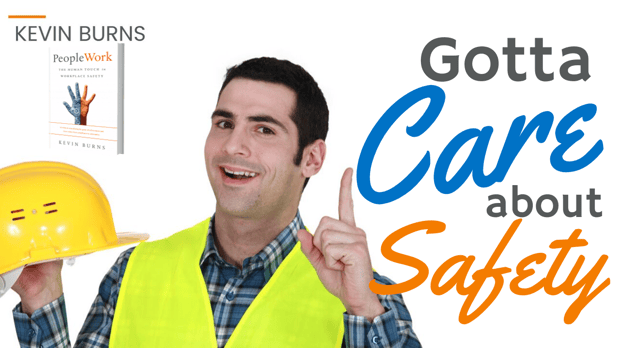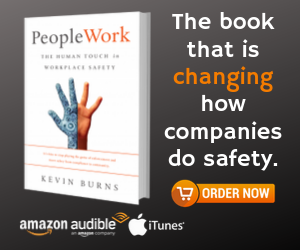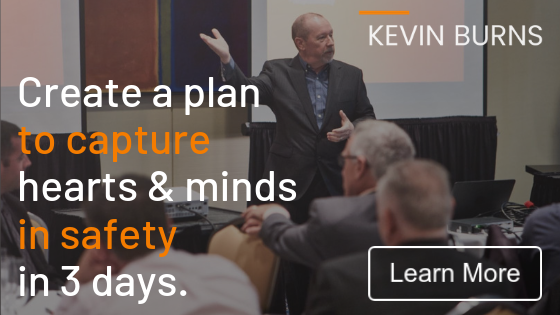Gotta Care About Safety
 One of the questions I am asked most often is: how do I get my people to care more about safety? The truthful answer is that they already do. What you don’t want to hear, is that what you’ve been selling them all of this time isn’t safety.
One of the questions I am asked most often is: how do I get my people to care more about safety? The truthful answer is that they already do. What you don’t want to hear, is that what you’ve been selling them all of this time isn’t safety.
You’ve been selling them paperwork, and rules compliance, and process and procedure. You’ve been selling them legislation, and consequence, and PowerPoint-heavy meetings and “wear your damn PPE.” You’ve been selling them officers and advisers looking over their shoulders waiting for them to mess up. And, you’ve been selling them “go home safe” as the point of the exercise. You’ve been selling them all of the things that THEY are required to do and very little of what YOU, the company, are going to give them. Now, learn how to improve the level to which employees care about safety by continuing to read and by watching the video below.
So says the research
The Gallup surveys tell us that the North American workforce is only 34% engaged. Nearly 70% of your people are not actively engaged in the work they are doing. And if 7 out of 10 of your employees are not engaged in their work, do you think they are even remotely engaged in safely doing the work they are not engaged in? So, if getting them engaged in their work isn’t part of the safety program, they’re not even listening. They’re tolerating another annoyance.
A TinyPulse survey tells us that employees want one thing above all others from their work. They want to fit in and to be recognized by their peers. Peer recognition and motivation is the highest priority item that employees want from their work. They want to fit in. Let’s put it another way, no one wants to feel like an outsider in their own job. No one wants to feel ostracized or to be outside of the group. If your safety program isn’t delivering a feeling like they belong as part of the group and to be recognized by their peers, then they have little interest in it.
Google’s Project Oxygen survey tells us that what employees want most from their immediate supervisor is someone who is a good coach. Not a decent boss but one who can coach them to better performance. People want to go to work to get better at something and they need a decent coach to help them along the way. If your safety program isn’t coaching better performance, improved mindset and a championship attitude, then you are down the priority list.
And, a LeadershipIQ survey tells us that employees want to succeed. Nothing motivates like success and when an employee achieves some success, it feels good. It feels so good that they want to do it again. And again, and again and again. Nothing motivates like success. And if your safety program isn’t giving your people a chance to succeed often, then it’s not high on the priority list.
Let’s summarize. Your people want to be able to engage better in the job but in order to do that, they need to fit in and be motivated by their peers, they need to be working with a really good coach, and they need to succeed which will drive more high-performance and success. Now ask yourself honestly, does your safety program offer that?
Safety is not separate
 The safety program doesn’t live in a bubble. It’s not separated from the work. Safety needs to be integrated into how we engage people, how they work with their peers, how they are coached and how often they get the chance to succeed.
The safety program doesn’t live in a bubble. It’s not separated from the work. Safety needs to be integrated into how we engage people, how they work with their peers, how they are coached and how often they get the chance to succeed.
Now ask yourself if that’s the workplace you are delivering to your people? Marcus Buckingham wrote in First Break All The Rules that a talented employee may join a company because of its leaders, its benefits, and its world-class training programs, but how long that employee stays and how productive he is while he is there is determined by his relationship with his immediate supervisor.
How many of your supervisors have been skilled and tooled-up to help their crews to deliver high levels of engagement, peer motivation, coaching excellence and opportunities to succeed. And that all supervisors are doing this consistently and all at a relatively consistent level?
People already care
People have to care about something. Your people already do. As the data shows, they already care about fitting in, being coached, being motivated by their peers, engaging in their work and feeling proud of the success they are having. That’s what your people care about. Now, make that relate to safety. A worker who doesn’t follow the rest of the employees doesn’t fit in. An employee who exposes his or her co-workers to undue risk doesn’t fit in. An employee who is uncoachable or who doesn’t want to get any better holds back the rest of the team. An employee who doesn’t want to be engaged or to give his or best effort daily holds the team back from success. That brings down the usual lecture from upper management and impacts the cohesiveness of the team.
On the front-line, as a supervisor, you need someone who can coach, motivate, communicate and engage their crews. Get your people to deliver their best effort daily, to be proud of their work and to celebrate their team successes and you have built a crew who doesn’t need to be reminded of achieving the bare minimum of safety. They are already operating far beyond that level.
Going home safe is not the goal
 Going home safe isn’t the goal. Going home better most certainly is. Coach your people to be better, to do better, to demand better and they will care about safety alright. And you won’t have to chase them around to meet the bare minimums.
Going home safe isn’t the goal. Going home better most certainly is. Coach your people to be better, to do better, to demand better and they will care about safety alright. And you won’t have to chase them around to meet the bare minimums.
If you want your people to care about safety, stop treating safety as the sum of its parts. Integrate safety as “simply how we work ‘round here.” Help your people to understand the value of safety more than the processes – how they benefit from being safe instead of how they face consequences for not following rules. Safety is not a thing you do, it is a result you get when you engage, build caring teams and help employees to find more success and meaning in their work.
Kevin Burns, consultant/author, works with smart, caring companies to energize safety culture, build teamwork, and get employee buy-in. Kevin is on a mission to help employees purposefully care about the work they do and to actively look out for the people they do it with. http://www.kevburns.com


